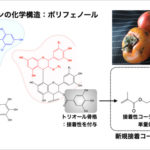(Lightweight Green Supercapacitors Could Quickly Charge Devices)
2020/9/7 アメリカ合衆国・テキサス A&M大学

・ テキサス A&M 大学が、リグニンを利用したスーパーキャパシタを開発。
・ バイオ材料のエネルギー貯蔵デバイスへの統合は、デバイスの寿命や性能を左右する最終的な電気特性の制御が難しく、慎重な扱いが必要。また、バイオ材料の生産プロセスには環境に厳しい化学処理が含まれる。
・ 今回開発したエネルギー貯蔵デバイスは、優れた電気性能を備え環境に優しく、低コストで安全・容易に製造できる。
・ エネルギー貯蔵デバイスである電池とスーパーキャパシタは、両者とも必要に応じて電流を供給するが、電池は単位体積当たりのエネルギー貯蔵量がより多く、スーパーキャパシタは短時間での大量の電流供給が可能で、電池に比して充電が速い。
・ スーパーキャパシタの内部構造は基本的なキャパシタと同様で、電極に電荷を蓄えるが、スーパーキャパシタはアプリケーション毎でのサイズ、形状や設計の自由度が高い。さらに、スーパーキャパシタの電極を様々な材料で作製することもできる。
・ 今回、電極製造に頻繁に利用されるルテニウムや亜鉛酸化物のような遷移金属酸化物に比して、より安価で供給量が豊富な二酸化マンガンナノ粒子に着目。ただし、同材料は導電性が低いことが難点であった。
・ 樹木の繊維を取り纏める天然のポリマーのリグニンと金属酸化物を組合せることで、電極の電気化学的特性が向上することが過去の研究で判明していたが、両材料の組み合わせによる有用な特性の活用に関する研究は少ない。
・ 精製したリグニンの過マンガン酸カリウムによる処理に続く、高熱・高圧下での酸化反応による過マンガン酸カリウムの分解により二酸化マンガンをリグニンに積層し、アルミニウム基板を二酸化マンガンとリグニンの混合物でコーティングして電極を作製。同新電極とアルミニウムと活性炭による電極でゲル電解質を挟み、スーパーキャパシタを作製した。
・ 同スーパーキャパシタの新電極の試験では、極めて安定した電気化学的特性を確認。特に比容量は数千サイクルの充放電後もほとんど変わらなかった。また、最適な比率のリグニン-二酸化マンガンでは、スーパーキャパシタでこれまでに報告されている比容量の 900 倍にもなることを確認。
・ 同スーパーキャパシタはまた、超軽量でフレキシブルなため、例えば車輌のエネルギー貯蔵構造部材としての利用も考えられる。今後の目標は、グリーンでサステナブルな材料のみを利用し、同スーパーキャパシタを 100%環境に優しいものにすること。
・ 本研究には、Texas A&M Energy Institute fellowship が資金を提供した。
URL: https://today.tamu.edu/2020/09/07/lightweight-green-supercapacitors-could-quicklycharge-devices/
<NEDO海外技術情報より>
(関連情報)
Energy Storage 掲載論文(アブストラクトのみ:全文は有料)
Design and synthesis of high performance flexible and green supercapacitors made of manganese‐
dioxide‐decorated alkali lignin
URL: https://onlinelibrary.wiley.com/doi/full/10.1002/est2.184
Abstract
State‐of‐the‐art flexible supercapacitors suffer from electrochemical and environmental performance issues including manufacturing expense limitations. Therefore, a highly effective and low‐cost strategy to develop supercapacitors is needed. To address this, a plant‐based, high‐performance, lightweight, low‐cost, quasi‐solid state, and composite electrode for flexible supercapacitors has been synthesized using the hydrothermal method. The composite electrode is made of alkali lignin and is decorated with MnO2 particles including an Al substrate. An Al/lig/MnO2 based anode and an Al/AC (activated carbon) based cathode were sandwiched using an inorganic polymer gel‐type electrolyte made of PVA/H3PO4 in order to assemble the supercapacitor. Synchrotron tomography and SEM are employed to study the detailed electrode morphology. Electrochemical impedance spectroscopy (EIS), cyclic charge‐discharge (CCD), and cyclic voltammetry (CV) have been used to assess electrochemical performance. Optimization is carried out using a series of lignin:MnO2 samples with varying constituent ratios. After 3000 charge‐discharge cycles, the highest specific capacitance value achieved at 40 mA g−1 reached 379 mF cm−2, (900 times reported). The capacitance retention, maximum energy density, and maximum power density are 80%, 6 Wh kg−1, and 355 W kg−1 respectively. Due to the superior electrochemical performance, the supercapacitor shows exceptional potential for future sustainable and green electronics.



